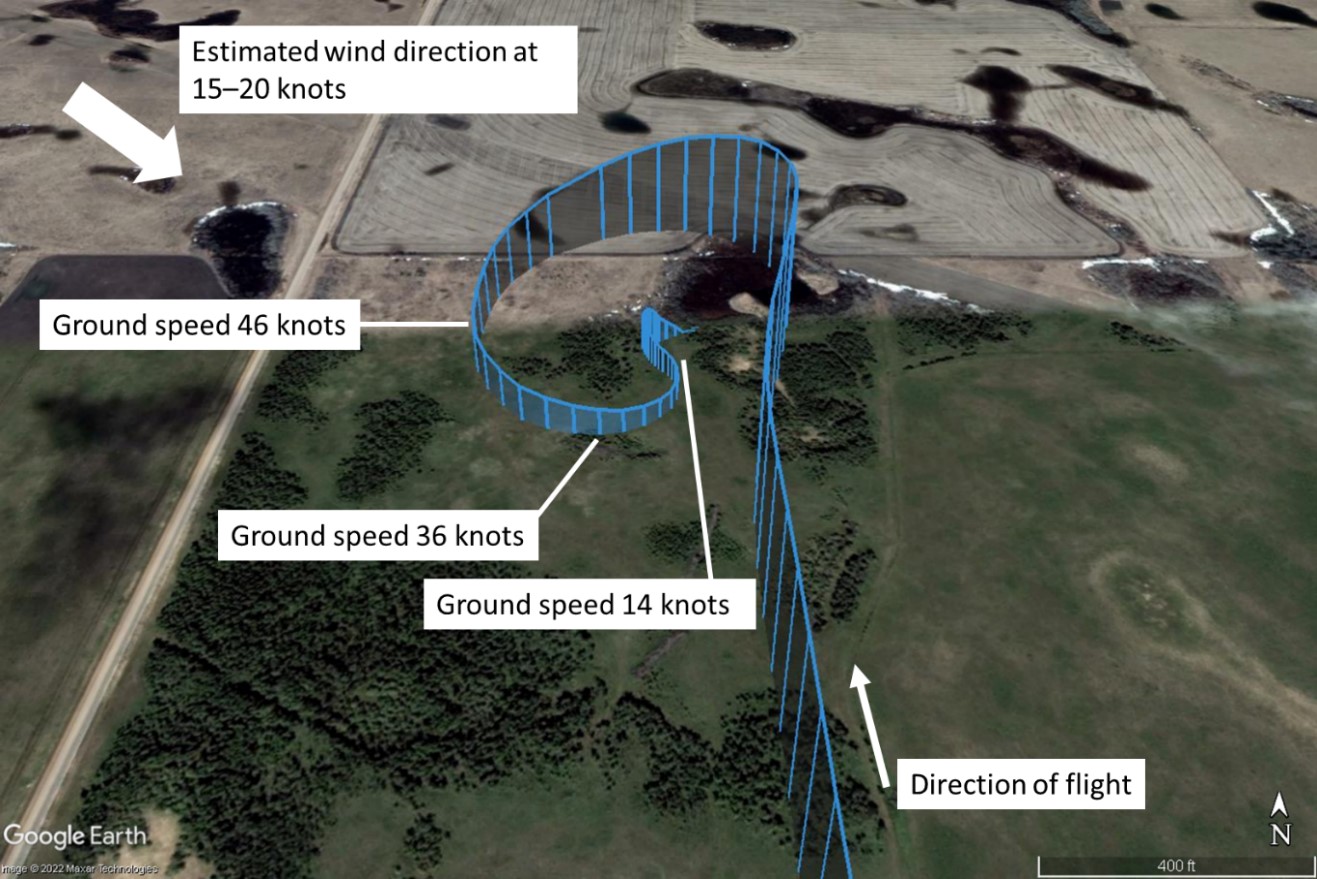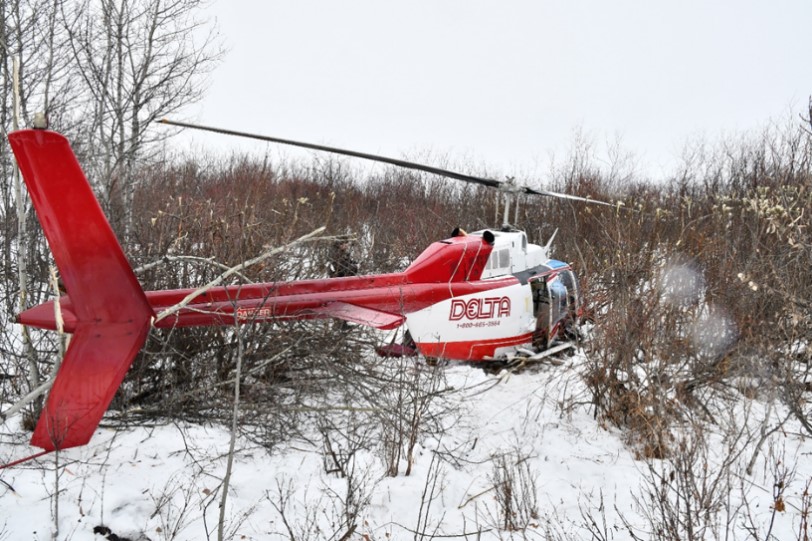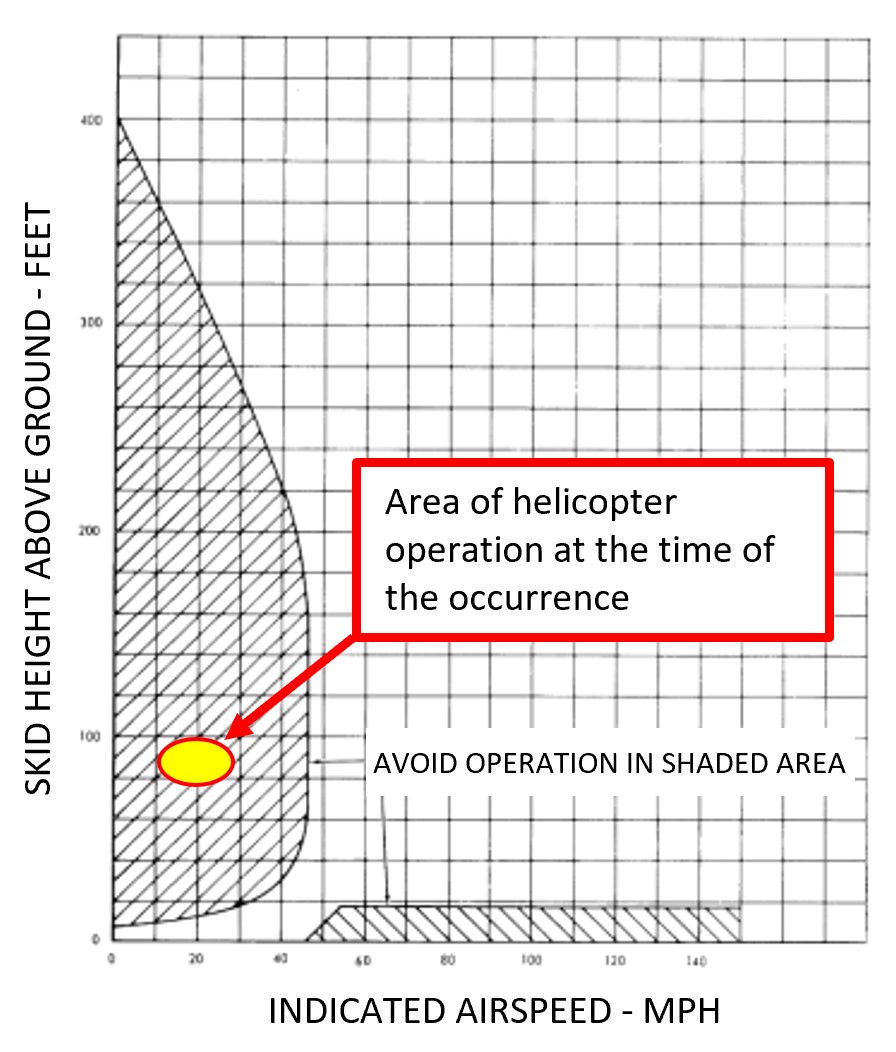Loss of control and collision with terrain
Delta Helicopters Ltd.
Bell 206B JetRanger II (helicopter), C-FCQJ
Camrose Aerodrome, Alberta, 23 NM ESE
The Transportation Safety Board of Canada (TSB) investigated this occurrence for the purpose of advancing transportation safety. It is not the function of the Board to assign fault or determine civil or criminal liability. This report is not created for use in the context of legal, disciplinary or other proceedings. See Ownership and use of content. Masculine pronouns and position titles may be used to signify all genders to comply with the Canadian Transportation Accident Investigation and Safety Board Act (S.C. 1989, c. 3).
History of the flight
At 0826Footnote 1 on 23 January 2022, the Bell Textron Inc. 206B JetRanger II (Bell 206B) helicopter (registration C-FCQJ, serial number 540) operated by Delta Helicopters Ltd. (Delta) departed Camrose Aerodrome (CEQ3), Alberta, to perform a series of wildlife survey flights on behalf of the Alberta provincial government. The pilot, 3 wildlife observers, their equipment, and approximately 65 U.S. gallons of fuel were on board.
This was the 6th consecutive day that wildlife survey flights had been conducted. The survey flights were generally flown at an altitude of approximately 2700 feet above sea level (ASL), which was approximately 300 feet above ground level (AGL), and at an indicated airspeed of approximately 90 knots. During the survey flights, when the observers spotted wildlife, the pilot slowed down, descended, and manoeuvred at a low altitude and slow speed so that the observers could count the animals and classify them by size and sex.
After departure, the pilot headed northeast toward the initial southbound survey line. The survey commenced at 0846 and was completed at 0920. The pilot then headed 2.5 nautical miles (NM) east toward the next survey line, which was flown in a northbound direction and commenced at 0922. During the course of the northbound survey, several low-altitude, slow-speed flight manoeuvres were performed so that the observers could survey the wildlife they had spotted. At approximately 0946, the observers spotted several animals in some scrub bush, and the pilot performed a descending, decelerating 360° left turn to allow the observers to count and classify the animals. After completing the left turn, the helicopter was on a track of 330° magnetic (M) at an altitude of approximately 2400 feet ASL (80 feet AGL) and at a ground speed of approximately 9 knots. At this time, the helicopter entered an uncommanded rotation to the right (Figure 1).
The pilot attempted to regain directional control; however, during the attempt, the helicopter descended and impacted terrain with little-to-no forward speed. The helicopter came to a rest in scrub bush in an upright position and largely intact. The landing skids were significantly spread apart due to the impact forces, and the rear landing skid cross tube was pushed up into the fuselage and ruptured the fuel cell. All occupants were seriously injured by the impact forces and were contaminated with jet fuel.
The occupants were all wearing the available lap belts and shoulder harnesses. None were wearing helicopter helmets, nor were they required to by regulation. Emergency medical services were contacted by a passenger in the helicopter and the services arrived on scene approximately 1 hour after the accident. All 4 occupants were transported to hospital for medical attention.
The 406 MHz emergency locator transmitter (Artex ME406HM) activated on impact.
Pilot information
The pilot held a valid commercial pilot licence — helicopter, which was endorsed for multiple helicopter types, including the Bell 206. He had accumulated approximately 2949 hours total time.
The pilot had been employed by Delta since April 2021. His total time on the Bell 206 at the beginning of his contract was 81.8 hours, and at the time of the occurrence, he had accumulated 113.2 hours on type.
The investigation determined that the pilot held the appropriate licence for the flight in accordance with existing regulations. The pilot received awareness training on loss of tail rotor effectiveness (LTE) in April 2021. A review of the pilot’s work and rest schedule indicated that fatigue was not likely a factor in this occurrence.
Aircraft information
The Bell 206B JetRanger II is a single-engine helicopter. It has a single 2-bladed, semi-rigid main rotor system. The helicopter had no known deficiencies before the occurrence flight.
The last 100-hour inspection was completed on the helicopter on 24 October 2021, at 27 525.8 hours total time airframe (TTAF). The left-side dual controls were removed from the helicopter on 16 January 2022 before the ferry flight to CEQ3, where the helicopter was to be based for the duration of the wildlife survey flights. The last maintenance activity accomplished was the 25-hour main and tail rotor greasing task, which was completed on 23 January 2022, before the occurrence flight.
The helicopter was being operated within its weight-and-balance and centre-of-gravity limits.
The helicopter was not equipped with a flight data recorder or cockpit voice recorder, nor was it required to be by regulation; however, the investigation recovered flight path data that had been recorded by a handheld GPS (global positioning system) being used by one of the passengers.
Weather information
CEQ3 does not have a weather reporting station. The nearest weather observation site is Edmonton International Airport (CYEG), Alberta, located approximately 32 NM northwest of CEQ3. The aerodrome routine meteorological report (METAR) issued at 1000 reported the following:
- Winds 300° true (T) at 9 knots
- Temperature +5° C
The upper winds at an altitude of 6000 feet ASL between 1000 and 1400 were reported as:
- Winds 310°T at 52 knots
- Temperature −2° C
Data collected during the course of the investigation indicated that, although the winds at the time of the accident were reported to be relatively steady at ground level, the flight had been bumpy. The graphic area forecast valid at the time of the occurrence indicated local areas of moderate and severe mechanical turbulence with low-level wind shear, and a low-level jet moving southeast at 50 knots in the vicinity of the accident site. This data was supported by the wind data provided by the atmospheric sounding balloon. Using the weather information available along with the GPS data, the investigation determined that the helicopter likely experienced winds from approximately 300°T (287°M) at 25 knots during the cruise portion of the flight.
Wreckage and impact information
Examination of the helicopter at the accident site indicated that the tail rotor blades were significantly damaged, and the steel tail rotor drive shaft located under the engine, between the engine reduction gearbox and the oil cooler blower assembly, was sheared in torsional overload. TSB investigators confirmed drive shaft continuity forward and aft of the failed driveshaft. Flight control continuity was also confirmed for all 4 axes. There were no signs of a pre-existing mechanical problem with the helicopter before the impact with terrain.
Low-altitude aircraft operation
Low-altitude operations are required for certain aerial work activity, such as external load operations, wildlife surveys, and pipeline or power-line inspection.
The Transport Canada Aeronautical Information Manual (TC AIM) contains the following warning in bold font regarding low flying:
Warning—Intentional low flying is hazardous. Transport Canada advises all pilots that low flying for weather avoidance or operational requirements is a high-risk activity.Footnote 2
Should an in-flight emergency occur requiring an immediate landing, the landing must be made irrespective of the condition of the surface below the flight path. Low flying provides few options for an immediate landing, and it may be difficult to successfully complete a landing.
The Bell 206B rotorcraft flight manualFootnote 3 includes a height-velocity diagram (Figure 3), which provides information and guidance to pilots on the safe operation of the helicopter. The height-velocity diagram defines the conditions from which a safe landing can be made following an engine failure in flight (emergency). A notation on the diagram encourages pilots to avoid operation in the shaded area.
Unanticipated yaw
When seen from above, the main rotor blades of the Bell 206B turn counterclockwise. Due to this rotation, the helicopter experiences a torque reaction in the opposite direction, which results in the helicopter yawing to the right (Figure 4).
To counter this movement, the helicopter is equipped with a tail rotor that produces lateral thrust. To compensate for the torque created by the main rotor during many normal regimes of flight, the pilot applies pressure to the anti-torque pedals to increase or reduce tail rotor thrust, as required.
However, when this yawing movement is not expected, it is referred to as an unanticipated yaw, or loss of tail rotor effectiveness (LTE), which is defined as follows:
LTE is a critical, low-speed aerodynamic flight characteristic which can result in an uncommanded rapid yaw rate which does not subside of its own accord and, if not corrected, can result in loss of aircraft directional control.Footnote 4
Any single-rotor helicopter flying at low speeds can experience LTE. This phenomenon is unrelated to equipment failure or defective maintenance; rather, it is the result of the tail rotor not providing sufficient thrust to maintain directional control.
Four relative windFootnote 5 azimuth regions can produce an environment that is conducive to LTE (Figure 5):
- main rotor disc vortex wind (winds from 285° to 315° relative to the helicopter);
- weathercock stability (winds from 120° to 240°);
- tail rotor vortex ring (winds from 210° to 330°); or
- loss of translational lift (winds from all directions).Footnote 6
In the section on LTE in the U.S. Federal Aviation Administration’s Helicopter Flying Handbook, emphasis is placed on the importance of recognizing the factors and conditions that can lead to an LTE event, and being prepared to recover from it. The section includes the following statement:
Unfortunately, there have been many pilots who have idled a good engine and fully functioning tail rotor disk and autorotated a perfectly airworthy helicopter to the crash site because they misunderstood or misperceived both the limitations of the helicopter and the aerodynamic situation.Footnote 7
An unanticipated yaw can pose a significant threat during flight at low speeds and in high power regimes, and when a helicopter is operated within critical wind azimuth regions. At the time of the occurrence, the helicopter was approximately 280 pounds below the maximum gross weight, and in an out-of-ground-effect hover (at 80 feet AGL). Winds were gusty and turbulent, and were coming from the left of the helicopter as the turn was being completed. Given the helicopter’s final track of 343°T (330°M), and the wind encountered likely coming from the general direction of 300°T (287°M), the relative wind was approximately 45° to the left of the helicopter’s nose (315° in Figure 5) and was somewhat lower than the 25 knots experienced at cruise altitude. As a result, the helicopter was operating in a high-power regime, within the critical wind azimuth regions of the main rotor disc vortex interference, and tail rotor vortex ring state.
In 1984, Bell Textron Inc. issued an information letterFootnote 8 to all owners and operators of Bell 206 series aircraft addressing the subject of slow-speed flight characteristics that could result in LTE. The letter was issued following significant flight testing completed on the U.S. Army’s OH-58 series of helicopters. The OH-58 is the military designation for the Bell 206 series of civilian helicopters. The letter covered the environmental (wind) conditions that can precipitate or lead to LTE, and the recommended recovery technique if an unanticipated right yaw event should occur.
Transport Canada reprinted the information from the Bell Textron Inc. information letter in Issue 4/85 of the Aviation Safety VortexFootnote 9 in an effort to reiterate the conditions that can lead to an unanticipated right yaw event. In addition, Transport Canada published an article in issue 1/2002 of the Aviation Safety Vortex discussing the conditions that could lead to LTE. This article was republished in issue 4/2017 of Transport Canada’s Aviation Safety Letter.
The following TSB investigation reports provide additional information on LTE: A20A0027, A16P0069, and A13W0070. These reports are available on the TSB’s website.Footnote 10
Safety messages
Pilots are reminded that flying an aircraft at low altitude leaves little margin for error and decreases the time and altitude available to effectively manage any unanticipated aircraft state.
Certain helicopter operations, such as slow-speed wildlife survey flights, lend themselves to being more at risk of LTE than other operations. In addition to understanding the LTE characteristics of their specific helicopter type, pilots need to pay close attention to airspeed, height and relative wind to ensure that LTE conditions are either avoided, or recognized and responded to immediately.
This report concludes the Transportation Safety Board of Canada’s investigation into this occurrence. The Board authorized the release of this report on . It was officially released on .



![Torque effect (Source: Transport Canada, TP 9982, Helicopter Flight Training Manual, Second Edition [June 2006], Figure 3.3)](/sites/default/files/eng/rapports-reports/aviation/2022/a22w0005/images/a22w0005-figure-04.jpg)
![Main rotor disc vortex interference and tail rotor vortex ring state angle based on relative wind direction and speed (Source: TSB, based on figures included in Federal Aviation Administration, Advisory Circular 90-95: Unanticipated Right Yaw in Helicopters [1995])](/sites/default/files/eng/rapports-reports/aviation/2022/a22w0005/images/a22w0005-figure-05.jpg)